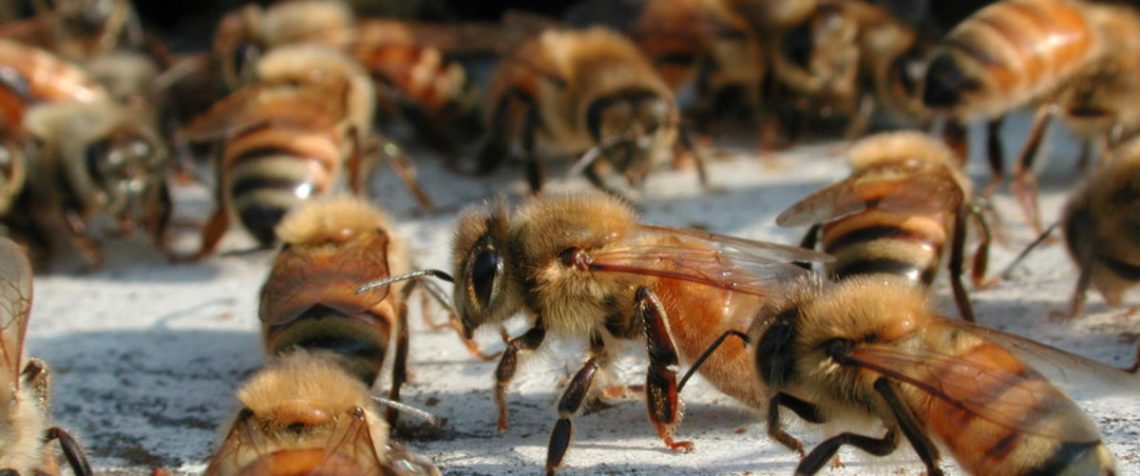
What you need to know about bees: the hierarchy in the hive and how long individual individuals live
Apiologs distinguish about 21 thousand species of bees. They are descendants of predatory wasps. Presumably, they gave up eating other types of insects, having repeatedly eaten various individuals covered with pollen.
A similar evolution took place about 100 million years ago. This proves the found fossil of a bee. The fossil had legs characteristic of predators, but the presence of abundant hair indicates belonging to pollinating insects.
The process of pollination existed long before the appearance of bees. Plants pollinated by butterflies, beetles and flies. But the bees turned out to be much more agile and efficient in this matter.
Now bees can live almost everywhere except Antarctica. They have adapted to feed on both nectar and pollen. Nectar replenishes energy reserves, and pollen contains all the nutrients they need. Two pairs of wings of different sizes (the front one is slightly larger) give the bees the ability to fly freely and quickly.
The smallest variety is the dwarf. It lives in Indonesia and reaches a size of up to 39mm. An ordinary bee grows to about 2mm.
Contents
Pollination
Bees are one of the largest groups of pollinators. They play an important role in the pollination of plants. They concentrate on both collecting nectar and collecting pollen. But pollen brings a much greater effect. For sucking nectar, they use a long proboscis.
The entire body of the bee is covered with electrostatic villi, to which pollen adheres. From time to time, they collect pollen from themselves with the help of brushes on their legs and move it to a pollen basket located between their hind legs. Pollen and nectar mix and form a viscous substance that moves into the honeycomb. Eggs are laid on this, and cells are closed. Therefore, adults and their larvae do not contact in any way.
dangers lurking
- The main enemy is birds that catch insects even on the fly.
- On beautiful flowers, danger also awaits. Triatomine bugs and sidewalk spiders will happily catch and eat the striped honey maker.
- The drugs used to get rid of harmful insects are very dangerous for striped pollinators.
How long does a bee live and what does it depend on
This question cannot be answered unequivocally, and it is worth considering each type of bee separately.
How long does a mother live?
The uterus resides longest life. Some valuable individuals live up to 6 years, but these are only those from which numerous offspring appear annually. Every year the queen lays fewer and fewer eggs. The uterus is usually replaced every 2 years.
How long does a drone live?
Drones appear in the spring. Two weeks pass before they reach puberty. Having inseminated the uterus, the male immediately dies. Drones that survived and did not fertilize the uterus survive until autumn. But they are not destined to live longer: the worker bees drive the drones out of the hive to save food. It rarely happens that the drone survives the winter in the hive. This can happen in a family where there is no uterus or it is infertile.
And so it turns out: most drones last only two weeks, others live almost a whole year.
How long does a worker bee live
The life of a worker bee depends on the season of its appearance. The spring brood lives 30-35 days, the June one – no more than 30. The brood that appeared in the honey collection period lives less than 28 days. Long-livers are autumn individuals. They need to live until spring, waiting for the honey season. In the Siberian climate, this period can be delayed for 6-7 months.
In colonies without brood, worker bees can live up to one year of age.
bee relationship
These insects are very organized. The search for food, water and shelter they produce together. They also defend themselves from enemies all together. In the hive, each performs its function. All of them contribute to the construction of honeycombs, care for the young and the uterus.
Bees are divided into two categories according to their organization:
- semi-public. Represents a group where there is a division of labor.
- Public. The group consists of a mother and her daughters, the division of labor is preserved. In such an organization there is a certain hierarchy: the mother is called the queen, and her daughters are called workers.
In the group, each bee performs its function. The professional area depends on the age of the individual. 3-4 days of life the worker bee is already beginning to clean the cells where she herself has recently appeared. After a couple of days, her glands produce royal jelly. And there is “upgrading”. Now she has to feed the larvae. In the moments free from feeding, she continues to clean and care for the nest.
The duties of nurses include the care of the uterus. They also feed the queen with royal jelly, wash her and brush her hair. The responsibility of about a dozen young bees is to monitor the safety and comfort of the queen. After all, as long as she is safe and sound, complete order reigns in the colony.
When the bee reaches two weeks of age, a change of specialization occurs again. The insect becomes a builder and will never return to his old duties. Waxy glands develop after two weeks of life. Now the bee will be engaged in the repair of old combs and the construction of new ones. She also accepts honey from foraging bees, recycles it, puts it in a cell and seals it with wax.
There are also so-called solitary bees. The name implies the existence in the group of only one species of females, which both breed and provide food for their offspring. They do not have a separate caste of workers. Such insects do not produce either honey or wax. But their big plus is that they sting only in cases of self-defense.
Solitary species equip nests in the ground or reed stalks. Like other types of bees, solitary females do not care about their offspring, they only guard the entrance to the nest. Males are born earlier, and by the time the females are born, they are ready to mate.
Parasitic bees
These individuals stealing food from other animals and insects. Representatives of this group do not have devices for collecting pollen, and they do not arrange their own nests. They, like cuckoos, lay their eggs in other people’s honeycombs, while destroying other people’s larvae. There are cases when the kleptoparasite family kills the owners of the nest and their queen, destroys all their larvae and lays their eggs.





